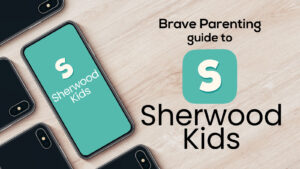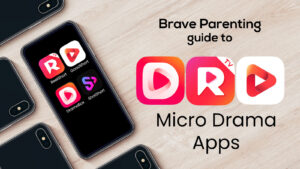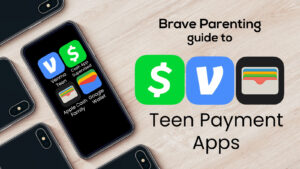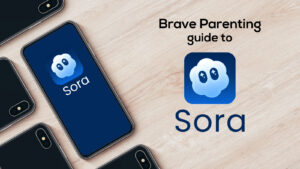Remember the days when you stretched out every curl from the tethered phone cord in desperate attempt to talk to your friends away from listening ears?
Or maybe you recall arguing with your sibling as they continued to pick up another house phone during your call. These are the sweet and precious memories of home phones.
If you are a parent of young children today, chances are low you still have a home phone or land line.
Lacking a home phone isn’t a problem while children are young. However, as children reach the age when they want to talk on the phone with their friends, lacking a home phone leaves limited options to meet the children’s desire to communicate.
The Two Assumed Solutions
When presented with this dilemma, parents contemplate their options: (1) Sharing their own phone with their child or (2) purchase a phone for the child to have their own.
Sharing a smartphone with your child means your number is distributed to the child’s friends (friends who generally lack communication skills and etiquette.)
These friends can now call and text you incessantly in order to access your child. If telemarketers are annoying, having 10 year old children call or text you repeatedly until you answer is downright painful.
For privacy reasons, many parents feel uneasy handing their smart phones over to their kids. Consider what is found on a parent’s phone: emails, text messages, banking apps, pictures, social media accounts, etc. It’s not hard to see why there is apprehension.
Unfortunately, more parents are allowing the unease of sharing their phones turn into validation for giving their children their own personal smart phone.
This is a major reason why the average age to receive a smart phone is 10.3 years old.
The child who just wanted to talk about silly stuff with her friend over the phone becomes the 10 year old child with a smart phone and screen obsession. She becomes the 10 year old who is begging for social media accounts or perhaps already has them and is posting regular selfies for strangers and predators to see.
For a child of any age, smartphone ownership is a steep and slippery slope – especially when parents are oblivious to how toxic, addictive, and dangerous they can be.
The Better Alternative
The third option to meet our children’s desire to communicate outside the walls of home is to have a Home Smartphone. This is exactly as it sounds: a smartphone (easiest to use an old model you have laying around) given its own phone line and set in a designated place in your home for anyone to use.
It should have tight restrictions regarding internet use, social media, app store, games, etc. while allowing phone calls and text messages to approved people.
Children use this phone to communicate while preventing the overwhelming obsession a personal smart phone brings.
There are so many advantages to having a Home Smart Phone, all of which help flatten the steepness of the slope and ease our children into smart phone use:
- Children practice confidence and communication skills by talking on the phone with peers.
As digital communication increases, oral communicating abilities – a characteristic always needed – become severely lacking. - Children can practice appropriate texting in an open and controlled environment.
Parents/siblings will be able to read text messages reinforcing the truth that nothing is really “private” and once it’s said, it’s out there forever. Additionally, children can learn basic and appropriate text language as well as adjusting for lack of nonverbal cues. Because contrary to popular belief, these are not inherent skills. IMPORTANT: Make sure you turn multi-media texting off to prevent sending and receiving pictures.
- You permit access to only the contacts you want.
Service providers (such as AT&T) allow for parental limits such as time of day and permitted contacts. The Home Smart Phone can allow incoming and outgoing calls and messages from 3-8pm only, for example. You can even block everyone but a few chosen people (Mom, Dad, Grandma, Grandpa, neighbor, etc.) both for phone calls and text messages. - With proven trust and responsibility, you can add more of your child’s friends as permitted contacts for them to talk and text with.
- Sharing with siblings builds character
- Peace of mind when children may need to be home alone.
- Other children won’t be calling or texting your phone in order to reach your child
Making it Work
A key to making this a successful transition into Smart Phone use is taking everything “smart” off of the phone.
These phone have enormous capabilities which no young adolescent needs access to. They only require a phone which can make calls and send texts. Like our childhood days, they know there is a phone for them to use to communicate.
Any time you combine smartphones and children, the best recommendation is to use the iPhone. Apple has built in restrictions that make safety and security ultra-easy.
As you set up your Home Smartphone consider the following limits to make this work:
- Turn off everything that makes the smart phones “smart.” RESTRICTIONS on an iPhone allows you to turn off Safari (internet), Camera, iTunes Store, Installing and Deleting Apps, Location services, Twitter and Facebook (which comes standard on iOS) and more. DO ALL OF THIS at first, you can add certain features later if needed.
You may decide to allow Facetime for face to face communication with grandparents, but note that Facetime should always be used in a public room, not behind closed doors.
- Define the ONE place the Home Smart Phone must stay. Will it be allowed away from the “home base”? (i.e. into bedroom, outside the house, etc.) Regardless, it needs home base where it remains and is charged.
This should not be in the child’s room as this sets up an expectation for phones in the bedroom when they do have their own phone. - Enter only the contacts allowed in clear and understandable terms such as “Grandma Smith” instead of Norma Smith. Add the allowed contacts to the favorites list for ease of use.
- Set up service provider limits to disable the ability to call or text anyone other than these approved numbers. This also allows for time limits to be set up for when phone can be used.
- Teach littlest ones how to make emergency calls
- Listen to your children place and receive calls. Are they courteous when answering? Do they start the conversation appropriately when the other person answers? Help teach them proper phone etiquette.
A Home Smart Phone is the perfect answer to your child begging for a phone and your conflicted spirit to grant their desire.
Be brave, don’t give into the cultural norm to give 10 year old children their own phone, much less one with unrestricted access. Stand up for their still-developing character and the years of childhood they can still enjoy before assuming media responsibility like adults.













